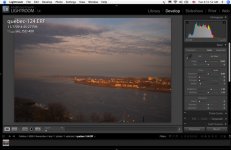kalex
Established
Yes you can but that defeats the purpose of RAW files. once you convert to jpg u start to loose quality and if you then edit the file in LR or PS you degrade it even more.
I had no problems using PhotoRaw on Mac. Software itself is pretty crappy and not very user friendly but it does work. That's why I'm trying to figure out how I can make it look decent.
Back Alley - can you do me a favor and try to open the erf file in Elements and let me know if it looks like LR or PhotoRaw. if you can please post a screen shot of what it looks like on your computer.
Raw file:
http://www.gololed.net/epson/quebec-124.ERF
Thanks
Alex
I had no problems using PhotoRaw on Mac. Software itself is pretty crappy and not very user friendly but it does work. That's why I'm trying to figure out how I can make it look decent.
Back Alley - can you do me a favor and try to open the erf file in Elements and let me know if it looks like LR or PhotoRaw. if you can please post a screen shot of what it looks like on your computer.
Raw file:
http://www.gololed.net/epson/quebec-124.ERF
Thanks
Alex


